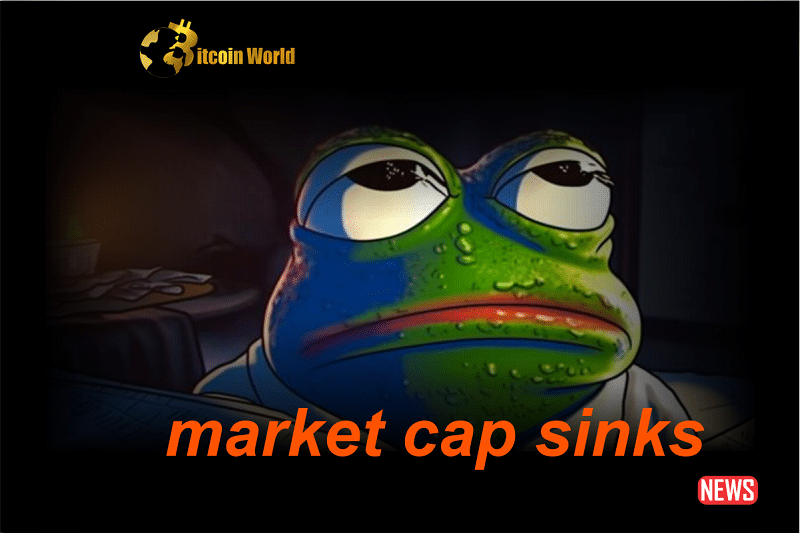The cryptocurrency world is no stranger to dramatic ups and downs, but the recent rollercoaster ride of the PEPE memecoin has been particularly eye-catching. Just a short while ago, PEPE was the talk of the town, boasting a staggering $1.8 billion market capitalization. Fast forward, and that figure has taken a significant hit. So, what exactly happened, and why are some big players still showing interest? Let’s dive into the fascinating, and perhaps slightly absurd, world of PEPE.
The Great PEPE Plunge: What Triggered the Dip?
Imagine a frog leaping to incredible heights, only to experience a rather swift descent. That’s a pretty apt analogy for PEPE’s recent price action. According to CoinGecko, the price of this meme-inspired token has plummeted by over 56% in just five days, dropping from a high of $0.00000431 to around $0.00000193. That translates to a hefty $1.1 billion shaved off its market cap since its peak on May 6th. Ouch!
But what fueled this dramatic downturn?
- Early Bird Profits: Experts at Matrixport suggest that early investors started cashing in their gains after PEPE got listed on Binance, the world’s leading crypto exchange. This influx of selling pressure from those who bought in early contributed significantly to the price drop.
- Retail Rush and Correction: The Binance listing likely attracted a wave of new retail investors, creating a surge in demand initially. However, as is often the case with meme coins, this hype can be followed by a sharp correction.
The Asian Connection: A Key Driver of PEPE’s Initial Surge
Interestingly, the rise of PEPE seems to have a strong connection to activity in Asian trading hours. Matrixport’s analysis revealed a mind-blowing statistic: buying activity during Asian trading hours contributed a whopping 3,657% to the memecoin’s overall 9,071% surge since its launch on April 14th. That’s a significant chunk of the upward momentum!
Further evidence points to a surge in Ethereum deposits on exchanges following PEPE’s debut. This suggests that many early investors, who acquired PEPE using ETH swaps on decentralized platforms like Uniswap and 1inch, were converting their PEPE profits back into Ethereum. Santiment noted that this activity pushed Ethereum deposits to levels not seen since November 2021.
Despite the Dip, Whales Are Still Nibbling
Here’s where things get even more interesting. Even with the significant price drop, some prominent crypto whales are still scooping up PEPE at lower prices. Think of it as buying the dip, but on a meme coin! Blockchain analytics firm Lookonchain highlighted the activity of “Machi Big Brother” (the online alias of Jeffrey Huang), who has purchased a substantial 73.4 ETH worth of PEPE (around $137,000) in just four days. His average purchase price is slightly below the current trading price, suggesting a belief in a potential rebound.
PEPE: Embracing the Absurdity
Unlike some other memecoins like Dogecoin and Shiba Inu, which have tried to develop additional utility and use cases, PEPE seems to revel in its lack of inherent value. In fact, the development team has explicitly stated that the token is “completely useless.” Yes, you read that right!
PEPE’s Unique Selling Proposition (or Lack Thereof):
- Intentionally Useless: The creators openly admit there’s no real-world application or financial return expected.
- Meme-Driven: Its value is purely based on internet culture and the popularity of the Pepe the Frog meme.
- No Roadmap or Team: There’s no formal structure, development plan, or identified team behind it.
This self-aware absurdity seems to be part of PEPE’s charm. The official website even includes a disclaimer stating: “$PEPE is a meme coin with no intrinsic value or expectation of financial return… The currency is utterly useless and is purely for fun.” For some investors, the irony and the potential for viral popularity are enough to warrant taking a punt.
So, What’s the Takeaway?
The PEPE saga highlights the wild and unpredictable nature of the cryptocurrency market, especially when it comes to meme coins. Here’s a quick recap:
| Aspect | Details |
|---|---|
| Price Drop | Over 56% in five days, losing $1.1 billion in market cap from its peak. |
| Key Factor | Profit-taking by early investors after Binance listing. |
| Asian Traders | Significant contributors to the initial price surge. |
| Whale Activity | Despite the dip, some whales are still buying. |
| Utility | Intentionally none; purely a meme coin. |
PEPE’s journey serves as a reminder of the risks and rewards associated with investing in highly volatile assets. While some see an opportunity for quick gains based on hype and community sentiment, others are wary of its lack of fundamental value. Whether PEPE will bounce back or continue its descent remains to be seen. One thing is certain: it’s a fascinating case study in the power of internet culture and the ever-evolving world of crypto.
Actionable Insight: If you’re considering investing in meme coins like PEPE, remember the inherent risks. Do your own research, understand that value is often driven by sentiment rather than fundamentals, and never invest more than you can afford to lose. The world of meme coins can be entertaining, but it’s crucial to approach it with caution and a healthy dose of skepticism.
Disclaimer: The information provided is not trading advice, Bitcoinworld.co.in holds no liability for any investments made based on the information provided on this page. We strongly recommend independent research and/or consultation with a qualified professional before making any investment decisions.


